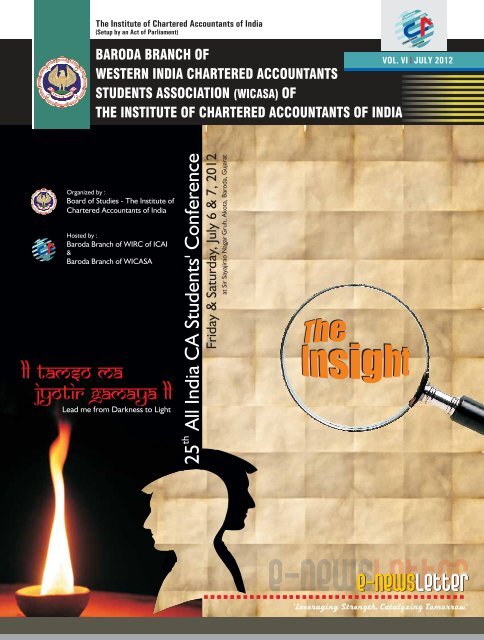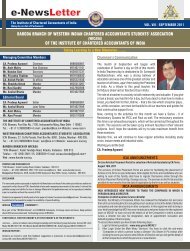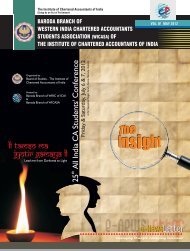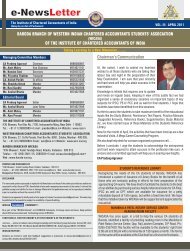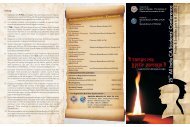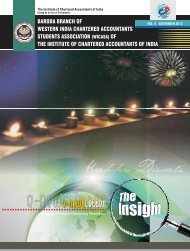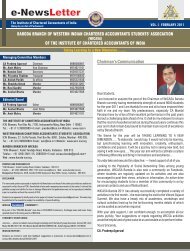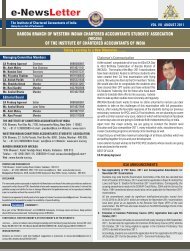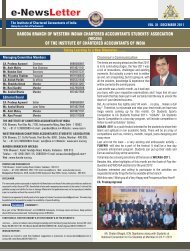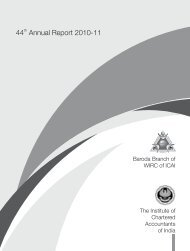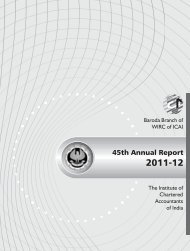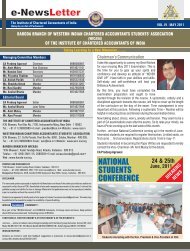e-NewsLetter e-NewsLetter - Baroda Branch of WIRC of ICAI
e-NewsLetter e-NewsLetter - Baroda Branch of WIRC of ICAI
e-NewsLetter e-NewsLetter - Baroda Branch of WIRC of ICAI
You also want an ePaper? Increase the reach of your titles
YUMPU automatically turns print PDFs into web optimized ePapers that Google loves.
The Institute <strong>of</strong> Chartered Accountants <strong>of</strong> India<br />
(Setup by an Act <strong>of</strong> Parliament)<br />
BARODA BRANCH OF<br />
WESTERN INDIA CHARTERED ACCOUNTANTS<br />
STUDENTS ASSOCIATION (WICASA) OF<br />
THE INSTITUTE OF CHARTERED ACCOUNTANTS OF INDIA<br />
Organized by :<br />
Board <strong>of</strong> Studies - The Institute <strong>of</strong><br />
Chartered Accountants <strong>of</strong> India<br />
Hosted by :<br />
<strong>Baroda</strong> <strong>Branch</strong> <strong>of</strong> <strong>WIRC</strong> <strong>of</strong> <strong>ICAI</strong><br />
&<br />
<strong>Baroda</strong> <strong>Branch</strong> <strong>of</strong> WICASA<br />
ll Tamso ma<br />
Jyotir Gamaya ll<br />
Lead me from Darkness to Light<br />
25 All India CA Students' Conference<br />
th<br />
Friday & Saturday, July 6 & 7, 2012<br />
at Sir Sayajirao Nagar Gruh, Akota, <strong>Baroda</strong>, Gujarat<br />
The<br />
Insight<br />
VOL. VI l JULY 2012<br />
e-<strong>NewsLetter</strong><br />
e-<strong>NewsLetter</strong><br />
“Leveraging Strength, Catalyzing Tomorrow”
Managing Committee Members<br />
<strong>Baroda</strong> <strong>Branch</strong> <strong>of</strong> WICASA<br />
<strong>of</strong> The Institute <strong>of</strong><br />
Chartered Accountants <strong>of</strong> India<br />
CA. Ashish Parikh Chairman 9825231545<br />
Mr. Sharukh Pathan Vice Chairman 8905094384<br />
Ms. Hiral Jethva Secretary 9714778552<br />
Mr. Mehul Thakkar Treasurer 8905564940<br />
CA. Nayan Kothari Ex-<strong>of</strong>ficio 9824433445<br />
Mr. Kanji Hadiya Member 9687969764<br />
Mr. Mohd.Atiq Qureshi Member 9998570095<br />
Mr. Dipesh Thakkar<br />
Editorial Board<br />
Member 9898940652<br />
CA. Ashish Parikh Editor<br />
Mr. Mohd.Atiq Qureshi Joint Editor<br />
Ms. Hiral Jethva Member<br />
THE INSTITUTE OF CHARTERED ACCOUNTANTS OF INDIA<br />
<strong>ICAI</strong> Bhawan, Post Box No. 7100, Indraprastha Marg,<br />
New Delhi - 110002. Tel. : +91 (11) 39893989<br />
E-mail : president@icai.org � Website : www.icai.org<br />
WESTERN INDIA CHARTERED ACCOUNTANTS STUDENTS<br />
ASSOCIATION<br />
<strong>ICAI</strong> Bhawan, 27, Cuffe Parade, Post Box No. 6081, Colaba,<br />
Mumbai - 400 005. Tel. : +91 (22) 39893989<br />
Email : wirc@icai.in � Website : www.wirc-icai.org<br />
BARODA BRANCH OF WICASA<br />
“<strong>ICAI</strong> Bhawan”, Kalali-Tandalja Road, Atladra, Vadodara - 390 012.<br />
Telefax : +91 (265) 2681115, 2680593<br />
E-mail: wicasa.baroda@gmail.com � Web : www.baroda-icai.org<br />
PRINTED AND PUBLISHED BY<br />
“<strong>ICAI</strong> Bhawan”, Kalali-Tandalja Road, Atladra, Vadodara - 390 012.<br />
Telefax : +91 (265) 2680593, 2681115 E-mail: baroda@icai.in Web : www.baroda-icai.org<br />
Designed at Multiprints, 30/B, Gandhi Oil Mill Compound,<br />
Near BIDC, Gorwa, Vadodara - 390 016.<br />
DISCLAIMER : The views and opinion expressed or implied in the Newsletter are those <strong>of</strong> the<br />
authors/contributors and do not necessarily reflect those <strong>of</strong> <strong>ICAI</strong>. Unsolicited articles and<br />
transparencies are sent at the owner's risk and the publisher accepts no liability for loss or<br />
damage. Material in this publication may not be reproduced, whether in part or in whole, without<br />
the consent <strong>of</strong> <strong>ICAI</strong>.<br />
Students are requested to kindly send article / paper <strong>of</strong> interest to wicasa.baroda@gmail.com.<br />
The same may be published in the newsletter subject to availability <strong>of</strong> space & editing.<br />
WICASA COMMUNITY :<br />
Be a part <strong>of</strong> the “WICASA <strong>Baroda</strong>” now also on FACEBOOK Community. Exchange views and<br />
news. Be updated about forthcoming events <strong>of</strong> WICASA.<br />
STUDENTS’ STUDY CIRCLE :<br />
Join now .... where in students can exchange knowledge with the help <strong>of</strong> group discussion.<br />
Contact Mr.Kanji Hadiya-9687969764<br />
BRAIN TRUST SESSION :<br />
Join now… where a group <strong>of</strong> students can discuss on predetermine questions and moderator<br />
(from CA fraternity) will elaborate the discussion and conclude. Contact Ms. Hiral Jethva-<br />
9714778552<br />
SPORTS ACTIVITIES:<br />
Join now…where in students can participate in Indoor-Outdoor games for overall development.<br />
Contact Mr. Dipesh Thakkar-9898940652<br />
WICASA HELPLINE :<br />
Students are invited to send their feedback suggestions or grievances to<br />
wicasa.baroda@gmail.com or contact Mr. Sharukh Pathan-8905094384, Mr. Mehul Thakkar-<br />
8905564940<br />
e-<strong>NewsLetter</strong><br />
“Leveraging Strength, Catalyzing Tomorrow”<br />
Dear Students,<br />
It gives me great pleasure to note the commemoration <strong>of</strong><br />
our “25th All India CA Students’ Conference” being<br />
organized by the Board <strong>of</strong> studies, <strong>ICAI</strong> and hosted by<br />
<strong>Baroda</strong> <strong>Branch</strong> <strong>of</strong> WICASA <strong>of</strong> the <strong>WIRC</strong> <strong>of</strong> <strong>ICAI</strong> on 6th & 7th<br />
July 2012 at <strong>Baroda</strong>.<br />
The theme <strong>of</strong> the conference is “Tamso Ma Jyotirgamaya –<br />
Lead me from Darkness to Light” The two-day Conference<br />
aims at putting light on a variety <strong>of</strong> subjects in way provide<br />
an aid to whole <strong>of</strong> CA Students fraternity in gaining<br />
expertise on diverse subjects that a Chartered Accountant<br />
undertakes in his day to day practice.<br />
This conference is being organized in which students from<br />
different parts <strong>of</strong> the nation have registered & will give<br />
them a common platform to explore their aptitude and to<br />
exchange views.<br />
I am very glad to announce that we got 1200+ participants<br />
for the conference & we have to stop registration before 10<br />
days <strong>of</strong> the commencement <strong>of</strong> the Conference. All the<br />
Students are working day & night sincerely from last 2<br />
months for the success <strong>of</strong> Conference. I am thankful to all<br />
<strong>of</strong> them.<br />
I wish “All the Best” to all the participants for the grand<br />
success <strong>of</strong> this mega event.<br />
Eager to see you on the days <strong>of</strong> Conference.<br />
Regards,<br />
CA. Ashish Parikh<br />
VOL. VI l JULY 2012 2<br />
“Nothing ventured, nothing gained.”<br />
Chairman’s<br />
Communication
Forthcoming Forthcoming Events Events<br />
<strong>Baroda</strong> <strong>Branch</strong> <strong>of</strong> WICASA<br />
<strong>of</strong> The Institute <strong>of</strong><br />
Chartered Accountants <strong>of</strong> India<br />
TH<br />
25 ALL INDIA CA STUDENTS' CONFERENCE<br />
e-<strong>NewsLetter</strong><br />
“Leveraging Strength, Catalyzing Tomorrow”<br />
VOL. VI l JULY 2012 3 “Whatever happens, take responsibility”<br />
Program Details<br />
* Confirmation Awaited<br />
For Registration & further details Contact contact : : BARODA BRANCH OF <strong>WIRC</strong> OF <strong>ICAI</strong>, <strong>ICAI</strong> Bhawan, Kalali- Tandalja Road, Tandalja, <strong>Baroda</strong> - 390 012 Gujarat, India.<br />
Ph. 0265- 2681115, 2680593 E-mail : wicasa.baroda@gmail.com Web : www.baroda-icai.org<br />
Past Events : May<br />
DATE TYPE OF EVENT<br />
NAME OF EVENT ATTEN.<br />
05/06/2012 ITT Batch Commencement <strong>of</strong> "98th ITT Batch" for PCC/IPCE Students 38<br />
08/06/2012 Interaction with President Meeting with President CA. Jaydeep Shah & WICASA Chairperson Shruti Shah 250+<br />
08/06/2012 Meeting WICASA Committee Meeting with President CA. Jaydeep Shah &<br />
WICASA Chairperson<br />
Shruti Shah 7<br />
11/06/2012 Oreintation Batch Commencement <strong>of</strong> "34th Orientation Batch" 51<br />
16/06/2012 Meeting All Committee Meeting for "25th All India CA Students Conference" 75+<br />
17/06/2012 Meeting Meeting with Ahmedabad branch <strong>of</strong> <strong>WIRC</strong> <strong>of</strong> <strong>ICAI</strong> 3<br />
18/06/2012 G.M.C.S Commencement <strong>of</strong> "34th G.M.C.S. Batch" 51<br />
23/06/2012 Banking A/c scheme for NRI Study Circle Meeting by Udit Patadiya 7<br />
30/06/2012 Meeting WICASA Committee Meeting with CA. Ajay Wadhwa 13<br />
30/06/2012 Meeting WICASA Committee Meeting with CA. Madhukar Hireganga -<br />
BOS Vice- Chairman 13
<strong>Baroda</strong> <strong>Branch</strong> <strong>of</strong> WICASA<br />
<strong>of</strong> The Institute <strong>of</strong><br />
Chartered Accountants <strong>of</strong> India<br />
General Tips To Overcome An Interview<br />
Contributed by : Vishal Mochi, CA Final Student<br />
TYPICAL QUESTIONS THAT AN INTERVIEWER WOULD ASK<br />
1. Tell me about you<br />
The most <strong>of</strong>ten asked question in interviews. You need to<br />
have a short statement prepared in your mind. Be careful<br />
that it does not sound rehearsed. Limit it to work/Studyrelated<br />
items unless instructed otherwise. Talk about<br />
things you have done well at your college and how you<br />
wanted to perform in the first job.<br />
2. Why Should We Employ You?<br />
For this question, your answer should list out strengths<br />
that you feel are relevant to the job. Given below are<br />
some answers which could help you with your answers.<br />
However, structure them to suit your requirements.<br />
� I have good co-ordination skills.<br />
� Good analytical skills.<br />
� I can persuade people to see my point <strong>of</strong> view, and get the<br />
work done.<br />
� My greatest asset is my ability to motivate people.<br />
� Even during emergencies, I do not loose my cool.<br />
� I have good entrepreneurial skills.<br />
� I have consistently met my deadlines and targets.<br />
� Can say “no” to people when required to do so!<br />
� I am very co-operative with my sub-ordinates, and would<br />
like to see them grow.<br />
� I am a good team player.<br />
� I am very flexible, and have the ability to work hard under<br />
difficult work conditions.<br />
� I have the experience and knowledge relevant to this job.<br />
(Here, give appropriate details and examples)<br />
3. Do You Have Offers From Other Companies?<br />
This is <strong>of</strong> course a difficult question to answer. Obviously,<br />
you must have applied to other companies if you are<br />
looking for a job or would have some <strong>of</strong>fers from other<br />
companies already. Therefore, do not lie that you have<br />
not. However, you are on thin ice here! The interviewer<br />
could be checking your honesty. On the other hand,<br />
he/she may also be trying to find out how focused you<br />
are - are you applying randomly, or is there a wellplanned<br />
strategy?<br />
Whatever your answer, it should match your career goals.<br />
4. What Salary Are You Expecting?<br />
Try not to get into salary details early in the interview. If<br />
pressed, you could say that it all depends on the job, and<br />
would like to talk about it after a job <strong>of</strong>fer. Say this in a<br />
convincing tone. In case you are asked this question in<br />
your latter interviews, give a direct answer. Do not sound<br />
apologetic while quoting the figure you have in mind.<br />
e-<strong>NewsLetter</strong><br />
“Leveraging Strength, Catalyzing Tomorrow”<br />
SALARY EXPECTATIONS:<br />
1. How much do you expect?<br />
VOL. VI l JULY 2012 4 “Creativity Is Like Electricity.”<br />
If you have done your homework, you would know how<br />
much other people in similar jobs are paid. Quote the<br />
range upfront.<br />
2. How much do you think you are worth?<br />
Work out how much you should be paid, given the market<br />
value <strong>of</strong> the job and your skills. If you can bring some<br />
extra skills to the table, do not hesitate to ask for more<br />
than the market value.<br />
3. What kind <strong>of</strong> a culture are you comfortable with?<br />
It is better to be frank about your preferences. Your<br />
interviewer will get a clear idea about your expectations.<br />
4. Which is more important to you-salary, perks or growth<br />
opportunities?<br />
This one will reveal the real you. So be sure what you are<br />
going to say. Above all, be true to yourself. If you think this<br />
is a negotiation move, then say clearly that you will never<br />
sell yourself short.<br />
5. What do you know about our company?<br />
Do not give your opinions about the company. Stick to<br />
reported facts that you have gathered from newspapers<br />
and so on. Talk about the product portfolio, size, income,<br />
and market perceptions <strong>of</strong> the company. Also it is better<br />
to refer details about each company before going for the<br />
interview from Freshersworld.com or<br />
PlacementWeek.com<br />
6. Why should we choose you over someone else?<br />
Talk clearly about problems that you have solved in your<br />
College/Project Team and highlight the quality required.<br />
7. Your qualifications are excellent, but you may be<br />
overqualified for the position we have to <strong>of</strong>fer?<br />
Point out that more experience can never be a drawback.<br />
If you are multi-skilled, then highlight the fact that a<br />
company on the fast-track needs multi-skilled people. It<br />
needs people within different departments to work<br />
together. Also emphasize that the company's future<br />
growth will be an exponential function <strong>of</strong> your<br />
experience.<br />
QUESTIONS YOU SHOULD ASK:<br />
Interviewers usually round <strong>of</strong>f by giving you an opportunity to<br />
ask questions. Treat it like a welcome opportunity.<br />
You could ask questions like.<br />
� Tell me about your company.<br />
� Now that I have outlined my career goals, do you think<br />
you can <strong>of</strong>fer me the opportunities I need?<br />
� What kind <strong>of</strong> training and learning can I expect in your<br />
company?<br />
�<br />
Describe the work culture and the management style <strong>of</strong>
<strong>Baroda</strong> <strong>Branch</strong> <strong>of</strong> WICASA<br />
<strong>of</strong> The Institute <strong>of</strong><br />
Chartered Accountants <strong>of</strong> India<br />
�<br />
your company?<br />
What is the long-term vision <strong>of</strong> your company?<br />
� As a fresher, current position and status can impact the<br />
way you are interviewed. Fresh Out <strong>of</strong> College<br />
� The basis on which you will be judged is your academic<br />
background, family background, and interests.<br />
� If looking for your first job, ensure that your previous<br />
experience, even if it is part-time, is noticed.<br />
� Mention projects or responsibilities you may have<br />
undertaken. This will indicate your area <strong>of</strong> aptitude.<br />
� You should be willing to put in regular hours, in line with<br />
the company's policies. The interviewer needs to know<br />
whether you can be punctual and put in full-time work.<br />
� In case you have applied for the post <strong>of</strong> management<br />
trainee, you should display an ability to adapt, and<br />
indicate all-round interests. Moreover, you should have<br />
good interpersonal skills.<br />
� You should be enthusiastic to learn, and show<br />
commitment towards the organization, as the company<br />
will be spending a lot on your training.<br />
Bring with you :<br />
a) Copies <strong>of</strong> your resumes.<br />
b) References and letters <strong>of</strong> recommendations.<br />
First Impressions :<br />
There is a common saying that minds are made up within<br />
the first 5 minutes <strong>of</strong> an interview. So keep in mind these<br />
important first impression indicators. Walk in the door as<br />
if you already work there carry yourself as though you<br />
feel perfectly comfortable with the situation. Arrive on<br />
time or a little early. In the waiting area, politely tell the<br />
receptionist who you are meeting and in a friendly way,<br />
ask where you should sit. Take slow, deep breaths to help<br />
you remain calm and focused. When introduced to the<br />
interviewer, have a firm, but not painful, handshake.<br />
Smile. Have good posture when sitting or standing.<br />
Introduce yourself in a relaxed, confident manner. Have a<br />
well-groomed, pr<strong>of</strong>essional appearance. Project a<br />
feeling <strong>of</strong> confidence. Bring extra copies <strong>of</strong> your resume,<br />
some thing to write on and something to write with.<br />
VENTURE CAPITAL-THE CONCEPT<br />
Contributed by : Abhishek Shah, CA Final Student<br />
Mr. A, is having a new idea <strong>of</strong> irrigation system but no one is<br />
ready to finance his project. The reason behind that is:<br />
The System is very new and it is having a dark picture that<br />
whether traditional farmers will accept the system or<br />
not?<br />
Uncertainty about revenue generation.<br />
Financing the project means in this case financing the<br />
research for new system development?<br />
Traditional financiers are not ready to finance him due to the<br />
e-<strong>NewsLetter</strong><br />
“Leveraging Strength, Catalyzing Tomorrow”<br />
above mentioned reasons. Now what should Mr. A do?<br />
Should he quit his new idea? No, here the concept <strong>of</strong><br />
venture capital comes in the picture.<br />
Meaning:<br />
Dictionary meaning <strong>of</strong> venture is risky undertaking. Venture<br />
capital is a risky capital and having great amount <strong>of</strong><br />
uncertainty regarding recovery <strong>of</strong> principle. The capital is<br />
invested in equity or debt securities <strong>of</strong> young companies<br />
promoted by technocrats and entrepreneur who attempt to<br />
break new path. It is a financial source for new, high risk, high<br />
pr<strong>of</strong>it potential products as the projects belong to unknown<br />
and new segments or technologies.<br />
The venture capital industry understood globally as<br />
“independently managed, dedicated pools <strong>of</strong> capital that<br />
focus on equity or equity-linked investments in privately held,<br />
high-growth companies” (“The Venture Capital Cycle”,<br />
Gompers and Lerner, 1999).<br />
With capital financing, the venture capitalist acquires an<br />
agreed proportion <strong>of</strong> the equity <strong>of</strong> the company in return for<br />
the funding. Equity finance <strong>of</strong>fers the significant advantage <strong>of</strong><br />
having no interest charges. As it is owner’s capital financing<br />
that seeks a return through long-term capital investment<br />
rather regular interest payments.<br />
Venture capitalist invests in owner’s capital, and that capital is<br />
highly risky. Venture capitalist assumes higher risk by<br />
financing equity capital. That is why venture capitalists must<br />
have analytical and selection <strong>of</strong> that projects which truly<br />
compensate the exposed risk taken by them. Therefore, by<br />
investing in a business they typically require a seat on the<br />
company's board <strong>of</strong> directors, and usually do not take day-today<br />
control. Rather, the pr<strong>of</strong>essional venture capitalists act as<br />
mentors.<br />
Venture Capital Concept in India<br />
India is the developing country having yearly growth rate<br />
approx. at the rate <strong>of</strong> 8.5% to 9%.Every emerging country<br />
need technological development to expand its growth rate<br />
and having independency in technology. Such country also<br />
needs entrepreneur to create new market, to have modern<br />
technocrat ancillary industry, and have successful<br />
industrialist.<br />
In light <strong>of</strong> this to promote innovation, enterprise and<br />
conversion <strong>of</strong> scientific technology and knowledge based<br />
ideas into commercial production, it is very important to<br />
promote venture capital activity in India. Our country has<br />
tremendous potential for growth <strong>of</strong> knowledge-based<br />
industries. Entrepreneur with innovative ideas is also needed<br />
for sustainable growth <strong>of</strong> India.<br />
Such Entrepreneurs have to face hardship for getting finance<br />
from traditional sources. Venture Capitalist is the persons<br />
who fill gape by financing such projects.<br />
VOL. VI l JULY 2012 5 “Happiness depends upon ourselves”
<strong>Baroda</strong> <strong>Branch</strong> <strong>of</strong> WICASA<br />
<strong>of</strong> The Institute <strong>of</strong><br />
Chartered Accountants <strong>of</strong> India<br />
e-<strong>NewsLetter</strong><br />
“Leveraging Strength, Catalyzing Tomorrow”<br />
In 1973, a committee on Development <strong>of</strong> Small and Medium Enterprises highlighted the need to foster venture capital as a<br />
source <strong>of</strong> funding new entrepreneurs and technology. Thereafter some public sector funds were set-up but the activity <strong>of</strong><br />
venture capital did not gather momentum as the thrust was on high-technology projects funded on a purely financial rather<br />
than a holistic basis.<br />
Later, a study was undertaken by the World Bank to examine the possibility <strong>of</strong> developing venture capital in the private sector,<br />
based on which the Government <strong>of</strong> India took a policy initiative and announced guidelines for venture capital funds (VCFs) in<br />
India in 1988. However, these guidelines restricted setting up <strong>of</strong> VCFs by the banks or the financial institutions only.<br />
Internationally, the trend favored venture capital being supplied by smaller-scale, entrepreneurial venture financiers willing to<br />
take high risk in the expectation <strong>of</strong> high returns, a trend that has continued in this decade. The Government <strong>of</strong> India issued<br />
guidelines in September 1995 for overseas venture capital investment in India and as a part <strong>of</strong> its mandate to regulate and to<br />
develop the Indian capital markets, Securities and Exchange Board <strong>of</strong> India (SEBI) framed SEBI (Venture Capital Funds)<br />
Regulations, 1996.<br />
SEBI (Venture Capital Funds) Regulation, 1996<br />
MEANING<br />
Any company or trust or a body corporate proposing to carry on any activity as a venture capital fund shall make an application<br />
to the Board for grant <strong>of</strong> a certificate.<br />
REGISTRATION<br />
An application for grant <strong>of</strong> certificate shall be made to the Board in Form A.<br />
Application fess is <strong>of</strong> Rs. 1,00,000 and non-refundable fees is <strong>of</strong> Rs.10,00,000<br />
The fees specified above shall be payable by bank draft in favors <strong>of</strong> “The Securities and Exchange Board <strong>of</strong> India” at<br />
Mumbai.<br />
ELIGIBILITY CRITERIA<br />
Criteria A company A Trust<br />
Its main objective, the carrying on <strong>of</strong> the activity <strong>of</strong> a venture capital fund Memorandum <strong>of</strong> Trust Deed<br />
in<br />
It is prohibited by its memorandum and articles <strong>of</strong> association from<br />
Association<br />
making an invitation to the public to subscribe to its securities<br />
�<br />
Its director or principal <strong>of</strong>ficer or employee is not involved in any litigation<br />
connected with the securities market which may have an adverse bearing<br />
on the business <strong>of</strong> the applicant<br />
� �<br />
Its director, principal <strong>of</strong>ficer or employee or trustee in case <strong>of</strong> trust has<br />
not at any time been convicted <strong>of</strong> any <strong>of</strong>fence involving moral turpitude or<br />
any economic <strong>of</strong>fence<br />
� �<br />
And is a fit and proper person<br />
� �<br />
The Board may require the applicant to furnish such further information as it may consider necessary<br />
CONDITION OF CERTIFICATE<br />
The certificate granted under regulation subject to the following conditions, namely:--<br />
The venture capital fund shall abide by the provisions <strong>of</strong> the Act and these regulations;<br />
The venture capital fund shall carry on only the activity <strong>of</strong> venture capital fund;<br />
The venture capital fund shall forthwith inform the Board in writing if any information or particulars previously submitted<br />
to the Board are found to be false or misleading in any material particular or if there is any change in the information<br />
already submitted.<br />
INVESTMENT CONDITIONS AND RESTRICTION<br />
A venture capital fund may raise monies from any investor whether<br />
Indian,<br />
Foreign or<br />
non-resident Indian and<br />
VOL. VI l JULY 2012 6 “Nothing recedes like success.”
<strong>Baroda</strong> <strong>Branch</strong> <strong>of</strong> WICASA<br />
<strong>of</strong> The Institute <strong>of</strong><br />
Chartered Accountants <strong>of</strong> India<br />
e-<strong>NewsLetter</strong><br />
“Leveraging Strength, Catalyzing Tomorrow”<br />
by way <strong>of</strong> issue <strong>of</strong> units<br />
No venture capital fund shall accept any investment from<br />
any investor, which is less than Rs. 5, 00,000.<br />
The above minimum investment amount condition shall<br />
not apply to investors who are<br />
Employees or the principal <strong>of</strong>ficer or directors <strong>of</strong> the<br />
venture capital fund, or directors <strong>of</strong> the trustee company<br />
or trustees where the venture capital fund has been<br />
established as a trust;<br />
The employees <strong>of</strong> the fund manager or asset<br />
Management Company.<br />
Way to understand Accounting in Practice<br />
Contributed by : Jatin Pal, CA Final Student, Ludhiana<br />
At one end introduction <strong>of</strong> Corporate Governance,<br />
mandatory application <strong>of</strong> well-conceived and stringent<br />
Accounting Standards one after another and growing<br />
regulatory role <strong>of</strong> SEBI in India and at the other end the<br />
colossal accounting fraud, auditor-auditee collusion and<br />
window dressing <strong>of</strong> accounts under camouflaged wording <strong>of</strong><br />
audit report have put the accounting pr<strong>of</strong>ession on the cross<br />
road <strong>of</strong> creative accounting.<br />
Each scheme launched or fund set up by a venture capital<br />
fund shall have firm commitment from the investors for<br />
contribution <strong>of</strong> an amount <strong>of</strong> at least Rs. 5 crores before<br />
the start <strong>of</strong> operations by the venture capital fund.<br />
Venture Capital fund may invest in Securities <strong>of</strong> foreign<br />
companies subject to guidelines given by RBI and SEBI.<br />
Venture capital fund should not invest in the equity<br />
shares <strong>of</strong> any company or institution providing financial<br />
services<br />
What is creative accounting? It is a novel nomenclature used<br />
for the concept <strong>of</strong> maintaining accounts to give all possible<br />
illegal and dubious benefits to the entirety.<br />
This sort <strong>of</strong> accounting is the need <strong>of</strong> corporate. Company<br />
management may adopt various methods to dress up<br />
financial statements to show improved performance. In<br />
respect <strong>of</strong> pr<strong>of</strong>it & loss account, the accounting risk is<br />
usually the overstatement <strong>of</strong> income or understatement<br />
<strong>of</strong> expenses. For the balance sheet, it may exist in three<br />
Restrictions on investment in other venture capital fund: areas, the correct valuation <strong>of</strong> company’s assets, accounting<br />
Investment restriction made in other venture capital for all liabilities and over <strong>of</strong> understatement for net worth.<br />
fund :<br />
The effect <strong>of</strong> creative accounting may defeat the purpose<br />
Venture<br />
Proposed(to)/ Unlisted<br />
<strong>of</strong> presentation <strong>of</strong> “true and Fair” financial statements.<br />
Capital Fund Listed<br />
Do you want to accept creative accounting? You may at best<br />
Minimum Not Specifically 66.67%<br />
investment given<br />
Maximum 33.33% Not Specifically<br />
investment given<br />
Not more than 25% should invest in one Venture Capital Fund<br />
Investment in proposed security can be made by way <strong>of</strong><br />
subscribing<br />
get a quicker promotion in your job or a couple <strong>of</strong> millions<br />
increase in the fees as an auditor! Not at all …..Never. Above<br />
all reality can be deferred, but it can never be denied. If we<br />
introspect minutely, we would agree and appreciate that the<br />
accounting pr<strong>of</strong>ession is growing and glorifying in passage <strong>of</strong><br />
time by perceptible improvement <strong>of</strong> accounting standards<br />
and related regulations, consciousness and alertness among<br />
the intellectuals and investors fraternity. And this is the<br />
Shares<br />
reason why the recent scams have come to lime light so soon,<br />
Debt or debt instrument <strong>of</strong> such fund in which fund has even if, maneuvered so shrewdly by so called top notch world<br />
already made investment by way <strong>of</strong> equity, preferential class companies and audit firms.<br />
allotment, subject to lock-in period <strong>of</strong> 1 Year.<br />
No theory <strong>of</strong> accounting standards or related regulatory<br />
Prohibition on Listing<br />
mechanism can ensure true and fair accounts unless the<br />
Venture Capital Fund shall be entitled to get its units listed on<br />
any recognized stock exchange only after the expiry <strong>of</strong> three<br />
years from the date <strong>of</strong> the issuance <strong>of</strong> units by the venture<br />
capital fund.<br />
GENERAL OBLIGATION AND RESPONSIBILITY<br />
A venture capital fund can receive money for investment in<br />
the venture capital fund only through private placement <strong>of</strong> its<br />
units. Venture capital fund cannot issue any advertisement or<br />
<strong>of</strong>fer document to public for inviting money.<br />
MAINTENANCE OF BOOKS AND RECORDS<br />
Every venture capital fund is required to maintain records<br />
for a period <strong>of</strong> 8 years.<br />
accountants and the management at the helm <strong>of</strong> affairs <strong>of</strong> the<br />
company are committed and sincere on the issue. Further, the<br />
management <strong>of</strong> the company <strong>of</strong> which accounts are true, fair<br />
and transparent is in a better position to take suitable<br />
managerial decision for remedy <strong>of</strong> past errors as well as<br />
future growth.<br />
Few areas <strong>of</strong> accounts - which all associated with accounts <strong>of</strong><br />
a company either directly or indirectly - accountants,<br />
management, investors, banks, financial institutions, stock<br />
exchanges, SEBI etc. should closely monitor. These are very<br />
simple to understand but can <strong>of</strong>fer a reasonable level <strong>of</strong><br />
confidence about the fidelity and fairness <strong>of</strong> accounts and<br />
efficiency <strong>of</strong> operation. By this you can satisfy the wants to<br />
society.<br />
VOL. VI l JULY 2012 7 “Be Curious, not judge mental.”
GROWTH OF SALES VS. EARNINGS:<br />
<strong>Baroda</strong> <strong>Branch</strong> <strong>of</strong> WICASA<br />
<strong>of</strong> The Institute <strong>of</strong><br />
Chartered Accountants <strong>of</strong> India<br />
There should be some parity in growth rate between sales<br />
and earnings otherwise it should be thoroughly analyzed. It<br />
is prudent to compare the topline growth <strong>of</strong> an enterprise<br />
with that <strong>of</strong> the industry in which the enterprise operates.<br />
This would indicate whether the enterprise is<br />
outperforming its competitors or lagging behind. All interdivisional<br />
sales including sales to associate, parent or<br />
subsidiary companies should be excluded while evaluating<br />
the performance.<br />
SALES VS. DEBTORS: A perpetual monitoring is necessary<br />
between sales and debtors to find out whether there is any<br />
efforts to push the sales while remaining slack on collection<br />
or allowing more liberal credit terms than warranted. One<br />
should find out the 'Debtors Days' or 'Collection Period'<br />
which represents the average number <strong>of</strong> days’ credit<br />
customers takes before paying <strong>of</strong>f their accounts. The<br />
formula for calculation is : Debtors / Sales *365 .<br />
CAPITALIZATION OF EXPENSES:<br />
All major capital expenditures need to be analyzed to find<br />
out whether they really refer to acquisition <strong>of</strong> assets having<br />
utility over a period <strong>of</strong> time or just an effort to capitalize<br />
revenue expenditure.<br />
MATCHING CONCEPT :<br />
Both revenue and related expenditure should be booked in<br />
the same period. For example, income from annual<br />
maintenance contract and expenses for maintaining such<br />
service should relate to same period.<br />
DEBTORS AND INVENTORY:<br />
These two items should always be analyzed with age-wise<br />
break-up to indicate their realizable value. Debtors<br />
outstanding for more than 6 months needs microscopic<br />
view since generally speaking the longest credit period<br />
allowed in industry is 6 months. Inventory level should be<br />
reviewed with respect to lead time for procurement and<br />
manufacturing cycle. In case <strong>of</strong> industry like electronics ,<br />
telecom etc. where the rate <strong>of</strong> obsolescence is very high due<br />
to rapid technical change, value <strong>of</strong> inventory should be<br />
closely evaluated.<br />
RETURN ON CAPITAL EMPLOYED:<br />
ROCE is expressed as the pr<strong>of</strong>it before interest and tax<br />
(PBIT) as percentage <strong>of</strong> total capital Employed (CE) which<br />
includes all long term funds i.e. shareholders' funds plus<br />
long term borrowings. This ratio <strong>of</strong>fers a first hand clue<br />
whether the company is able to generate adequate return<br />
to service its debts and <strong>of</strong>fer suitable return to its<br />
shareholders. To have better understanding, ROCE for last<br />
few years <strong>of</strong> the company as well as that <strong>of</strong> other companies<br />
in the same industry should be analyzed.<br />
CASH FLOW STATEMENT<br />
“Cash is King" - is the cliché in the modern finance world.<br />
VOL. VI l JULY 2012 8 “Aim for the highest.”<br />
e-<strong>NewsLetter</strong><br />
“Leveraging Strength, Catalyzing Tomorrow”<br />
The interesting fact is that how much manipulation or<br />
fabrication one may do in accounts, he cannot hide position<br />
<strong>of</strong> cash - which is the ultimate source <strong>of</strong> survival and<br />
growth <strong>of</strong> any organization. Cash Flow Statement is now a<br />
mandatory statement in all Annual Reports. Of this report,<br />
the segment called cash flow from operating activity is the<br />
most important one. Cash flow is calculated by adding back<br />
net pr<strong>of</strong>its <strong>of</strong> the company non-cash expenditure like<br />
depreciation and amortization <strong>of</strong> intangible and deferred<br />
revenue expenditure and followed by adjustment for<br />
movement <strong>of</strong> working capital i.e. increase or decrease in<br />
debtors, inventory and debtors. Any mismatch in cash<br />
generation vis-à-vis sales increase or negative cash<br />
generation should be the first and foremost area to be<br />
scrutinized to see whether the business is on the right track. It<br />
is the cash management which can make a company survive<br />
or bankrupt.<br />
IMPACT OF CONTINGENT LIABILITY:<br />
Contingent liabilities which do not figure in the Balance Sheet<br />
are expressed in form <strong>of</strong> a note to the accounts. These are<br />
based more on perception <strong>of</strong> the management. Auditors<br />
should thoroughly analyze these cases and express their frank<br />
and candid opinions as far as possible. Similarly, investors and<br />
other external agencies should go through the same to have a<br />
feeling <strong>of</strong> extreme scenario in case <strong>of</strong> worst eventualities.<br />
Lastly, where as an accountant should pledge to per-form<br />
without fear and favor, the corporate management should<br />
ensure sound and impartial internal control system, periodic<br />
affirmation <strong>of</strong> corporate code <strong>of</strong> con-duct and increased<br />
vigilance by audit committee. Last but not least, an auditor<br />
should not hesitate to qualify the accounts, if the company is<br />
unable or unwilling to prepare financial statements, which<br />
give a true and fair view.<br />
What do the numbers on the bottom <strong>of</strong> the<br />
Cheque represent?<br />
Contributed by: Vaibhav Thakkar (CA. Final Student)<br />
I. Cheque Number:<br />
The first set <strong>of</strong> numbers represents the Cheque number. It<br />
is a six digit number.<br />
ii. MICR Code:<br />
It stands for Magnetic Ink Character Recognition.<br />
This number helps a bank to recognize the bank and<br />
branch that issued the Cheque.<br />
The Cheque are sorted through a Cheque reading machine<br />
which uses this number to identify the bank and branch a<br />
Cheque belongs to. This makes the process faster.<br />
The MICR number is a nine digit number, which consists <strong>of</strong><br />
three parts-
<strong>Baroda</strong> <strong>Branch</strong> <strong>of</strong> WICASA<br />
<strong>of</strong> The Institute <strong>of</strong><br />
Chartered Accountants <strong>of</strong> India<br />
a) City Code: The first three digits represent the city code and<br />
are same as the first three digit <strong>of</strong> the PIN code <strong>of</strong> that city.<br />
e.g., a bank in Vadodara will have first three digits <strong>of</strong> MICR<br />
code as 390 (since PIN code for Vadodara starts with 390)<br />
b) Bank Code: The next three digits represent the bank code.<br />
Every bank has a unique code assigned to it. For e.g., ICICI<br />
bank’s code is 229, for HDFC it is 240 and so on.<br />
c) <strong>Branch</strong> Code: The last three digits represent the branch<br />
code.<br />
iii. Bank account Number:<br />
The third set <strong>of</strong> six digit numbers represents your account<br />
number maintained by the Reserve Bank <strong>of</strong> India (RBI).<br />
The number helps in Cheque processing when it goes to<br />
RBI for clearance.<br />
iv. Transaction ID:<br />
The last two digits tell whether a Cheque is a local Cheque<br />
our payable at par Cheque.<br />
29, 30 31 represents payable at par Cheque, while 09, 10<br />
and 11 represents local Cheque.<br />
One More Interesting Thing…<br />
These numbers are written in a different font style with a<br />
special ink usually iron oxide that contains magnetic material<br />
so that it can be recognized by Magnetic Character Ink Reader<br />
and also if it is stamped.<br />
Currency Carrying limits in FEMA<br />
Contributed by: Jatin Pal (CA. Final Student)<br />
PRELUDE -The draconian law enshrined in Foreign Exchange<br />
Regulation Act, 1973 comes to an end through Foreign Exchange<br />
Management Act, 1999 (Commonly Known as FEMA) which was<br />
made effective from 1st June , 2000. It’s the Central Government<br />
who made rules and regulations to make FEMA operationalized,<br />
Notifications, Directions, Circulars etc. issued by Reserve Bank <strong>of</strong><br />
India. FEMA Act extends to the whole <strong>of</strong> India and apply to all<br />
branches, <strong>of</strong>fices and agencies outside India owned or controlled<br />
e-<strong>NewsLetter</strong><br />
“Leveraging Strength, Catalyzing Tomorrow”<br />
VOL. VI l JULY 2012 9 “Talent works, genius creates.”<br />
by a person resident in India. It is also applicable to any<br />
contravention committed outside India by any person to whom<br />
this act is applicable. Offices <strong>of</strong> FEMA<br />
Which means Delhi have 7 Sub- Zonal Offices and 5 Fields<br />
Units, Similarly Bombay have their own 7 Sub- Zonal Offices<br />
and 5 Fields Units.<br />
In every country 2 types <strong>of</strong> foreign exchange transactions are<br />
there<br />
� One is Trade &<br />
� Second is Non-trade, the thrust <strong>of</strong> FEMA is more on arranging<br />
and managing these transactions rather than imposing<br />
restrictions and regulating them the way a watchdog does. In<br />
the era <strong>of</strong> liberalization as we are on the global platform,<br />
Rules and Regulations framed under FEMA are being relaxed<br />
from time to time to incorporate greater freedom so far as<br />
the conduct <strong>of</strong> foreign exchange transactions both by<br />
residents and non- residents is concerned. Authorised<br />
Dealers, the conduit between the Reserve bank and the<br />
public in general, are vested with increased delegatory<br />
powers so that cross-border trade, investments, remittances<br />
etc. are conducted more cordially and smoothly.<br />
Transactions involving foreign exchange have been–<br />
Classified either as capital or current account transactions.<br />
When you enter in to a foreign transaction and your<br />
Assets/Liabilities including contingent liabilities, does not alter,<br />
then it is a current account transaction. Section 5 <strong>of</strong> FEMA allows<br />
a person resident in India to buy or sell foreign exchange for any<br />
current account transaction except for those transactions for<br />
which withdrawal <strong>of</strong> foreign exchange has been prohibited by<br />
Central Government.<br />
Reserve Bank authorized dealers under Section 10(1) <strong>of</strong> FEMA,<br />
1999, to do transactions. They are –<br />
-Authorised Dealer (AD) Category-I bank<br />
-AD Category-II. Full-Fledged Money Changers (FFMCs) are also<br />
permitted to release exchange for business and private visits.<br />
(For list <strong>of</strong> Ads is available on www.rbi.org.in).<br />
FEMA Head-<strong>of</strong>fice in New Delhi (Headed By a Director)<br />
5 Zonal Offices (Headed By Deputy Directors)<br />
Delhi Bombay Calcutta Madras Jalandhar<br />
Each Zone further divided in to 7 Sub-Zonal Offices<br />
( Headed by the Assistant Directors)<br />
&<br />
5 Fields units (Headed by the Chief Enforcement Officers)
<strong>Baroda</strong> <strong>Branch</strong> <strong>of</strong> WICASA<br />
<strong>of</strong> The Institute <strong>of</strong><br />
Chartered Accountants <strong>of</strong> India<br />
e-<strong>NewsLetter</strong><br />
“Leveraging Strength, Catalyzing Tomorrow”<br />
Reason for going Abroad- Maximum Amount Allowed<br />
1. For tourism (Other Than Nepal and/or Bhutan) - Aggregrate amount <strong>of</strong> USD 10,000 for any one financial<br />
year, on self-declaration basis, irrespective <strong>of</strong> the<br />
number <strong>of</strong> visits undertaken during the year.*<br />
*You can avail this facility, even you are availing facility while visiting foreign for employment or immigration or studies.<br />
2. For Tourism to Nepal and/or Bhutan A resident Indian is allowed to take INR <strong>of</strong> denomination<br />
<strong>of</strong> Rs.100 or lesser denomination to Nepal and Bhutan<br />
without limit.<br />
3. For Business Trip (other than to Nepal and/or Bhutan) USD 25,000 per visit**<br />
**Business Visits means visits in connection with attending <strong>of</strong> an international conference, seminar, specialised training, study<br />
tour, apprentice training, etc.<br />
If you want release <strong>of</strong> foreign exchange exceeding USD 25,000 for business travel abroad (other than to Nepal and Bhutan),<br />
irrespective <strong>of</strong> the period <strong>of</strong> stay, requires prior permission from the Reserve Bank.<br />
4. For Business Trip (To Nepal and/or Bhutan) No release <strong>of</strong> foreign exchange is admissible<br />
5. For Medical Treatment USD 100,000 or its equivalent***<br />
*** AD Category-I banks and AD Category-II, may release foreign exchange up to USD 100,000 or its equivalent to resident<br />
Indians for medical treatment abroad on self-declaration basis, without insisting on any estimate from a hospital/doctor in<br />
India/abroad. A person visiting abroad for medical treatment can obtain foreign exchange exceeding the above limit, provided<br />
the request is supported by an estimate from a hospital/doctor in India/abroad.<br />
An amount up to USD 25,000 is allowed for maintenance expenses <strong>of</strong> a patient going abroad for medical treatment or check-up<br />
abroad, or to a person for accompanying as attendant to a patient going abroad for medical treatment/check-up.<br />
The amount <strong>of</strong> USD 25,000 allowed to the patient going abroad is in addition to the limit <strong>of</strong> USD 100,000 mentioned above.<br />
6. For Studies<br />
Student can avail this from AD Category-I bank and AD Category-II.<br />
USD100000 or the estimate received from the<br />
institution abroad, per academic year, whichever is<br />
higher.<br />
7. For Employment USD 100,000 on the basis <strong>of</strong> self-declaration<br />
Withdrawal Period : You can withdraw Permissible foreign exchange 60 days in advance. In case it is not possible to use the foreign<br />
exchange within the period <strong>of</strong> 60 days, it should be immediately surrendered to an authorized person. However, residents are free to<br />
retain foreign exchange up to USD 2,000, in the specified manner.<br />
Payment Mode : The value <strong>of</strong> foreign currency which we want to carry if, it is upto Rs. 50000 , then you can pay that in Cash. If, the<br />
value <strong>of</strong> foreign currrency is more than Rs. 50000, entire payment should be made by way <strong>of</strong> a crossed cheque/banker’s cheque/pay<br />
order/demand draft/debit card/credit card/prepaid card only.<br />
Surrender <strong>of</strong> foreign currency : When you return from a foreign trip, travellers are required to surrender unspent foreign exchange<br />
held in the form <strong>of</strong> currency notes and travellers cheques within 180 days <strong>of</strong> return. However, they are free to retain foreign exchange<br />
up to USD 2,000, in the specified manner. You can hold foreign coins without any limit.<br />
Usage <strong>of</strong> Cards : Holder <strong>of</strong> International Credit Cards (ICCs)/ATMs/Debit Cards can use it for travel abroad in connection with various<br />
purposes and for making personal payments like subscription to foreign journals, internet subscription, etc. If the person has a foreign<br />
currency account in India or with a bank overseas, he/she can even obtain ICCs <strong>of</strong> overseas banks and reputed agencies.<br />
Carrying Indian currency : In India, Residents are free to take outside India (other than to Nepal and Bhutan) currency notes <strong>of</strong><br />
Government <strong>of</strong> India and Reserve Bank <strong>of</strong> India notes up to an amount not exceeding Rs. 7,500 per person. They may take or send<br />
outside India (other than to Nepal and Bhutan) commemorative coins not exceeding two coins each.<br />
A resident <strong>of</strong> India, who has gone out <strong>of</strong> India on a temporary visit, may bring into India at the time <strong>of</strong> his return from any place outside<br />
India (other than Nepal and Bhutan), currency notes <strong>of</strong> Government <strong>of</strong> India and Reserve Bank <strong>of</strong> India notes up to an amount not<br />
exceeding Rs. 7,500.<br />
Foreign currency to India : A person coming into India from abroad can bring with him foreign exchange without any limit. However, if<br />
the aggregate value <strong>of</strong> the foreign exchange in the form <strong>of</strong> currency notes, bank notes or travellers cheques brought in exceeds USD<br />
10,000 or its equivalent and/or the value <strong>of</strong> foreign currency alone exceeds USD 5,000 or its equivalent, it should be declared to the<br />
Customs Authorities at the Airport in the Currency Declaration Form (CDF), on arrival in India.<br />
Export <strong>of</strong> gifts : A person resident in India is free to send (export) any gift article <strong>of</strong> value not eaxceeding Rs. 5, 00,000 provided export<br />
VOL. VI l JULY 2012 10 “Wisdom begins in wonder.”
<strong>Baroda</strong> <strong>Branch</strong> <strong>of</strong> WICASA<br />
<strong>of</strong> The Institute <strong>of</strong><br />
Chartered Accountants <strong>of</strong> India<br />
<strong>of</strong> that item is not prohibited under the extant Foreign Trade<br />
Policy and the exporter submits a declaration that goods <strong>of</strong> gift<br />
are not more than Rs. 5, 00,000 in value. Export <strong>of</strong> goods or<br />
services up to Rs. 5, 00,000 may be made without furnishing the<br />
declaration in Form GR/SDF/PP/SOFTEX, as the case may be.<br />
Revised Schedule VI<br />
EXPLANATION OF<br />
CURRENT ASSETS/LIABILITIES<br />
Contributed by: Mohd. Atiq Qureshi (CA. Final Student)<br />
The above bifurcation <strong>of</strong> assets and liabilities between current<br />
and non-current would require major reclassification in Balance<br />
Sheets <strong>of</strong> all companies and would have impact on the current<br />
ratio. Some <strong>of</strong> such instances <strong>of</strong> reclassifications are as under:-<br />
1) Presently even the current maturities to long term debt are<br />
shown as part <strong>of</strong> long term debt and only disclosure <strong>of</strong><br />
amount due to be repaid within one year is made. However,<br />
as per Revised Schedule VI current maturities to long term<br />
debt would be depicted as “Other Current Liabilities”.<br />
2) As per old schedule VI interest accrued and due on long term<br />
loans were shown as part <strong>of</strong> long term loans but in Revised<br />
Schedule VI the same is shown as Current Liabilities.<br />
3) Currently all loans and advances (except capital advances)<br />
are shown under Current Assets & Loans and Advances but<br />
now onwards the same need to be bifurcated between<br />
current and non-current, accordingly the sub heading <strong>of</strong> long<br />
term loans and advances has been introduced in Revised<br />
Schedule VI.<br />
4) The provisions also need to be bifurcated among long term<br />
and short term, the latter one being classified as current, and<br />
former being classified as non-current e.g. employee related<br />
provisions ; accordingly sub heading <strong>of</strong> long term provisions<br />
has been introduced. Under old Schedule VI all provisions<br />
were being shown under Current Liabilities and Provisions.<br />
5) Under old Schedule VI the trade receivables (Debtors) / trade<br />
payables (creditors) were always shown as Current, but in<br />
revised Schedule VI, these can also be shown as Non-Current.<br />
It appears that where the credit is <strong>of</strong>fered on deferred credit<br />
basis or the payment is not expected to be received from<br />
debtors within normal operating cycle/ 12 months from<br />
reporting period, the same need to be disclosed as Non-<br />
Current.<br />
EXAMPLES OF CURRENT ASSETS/LIABILITIES<br />
For understanding the above definitions let us apply the same in<br />
following cases<br />
Question 1 : As on 31st March, 2011, a property developer has<br />
inventories <strong>of</strong> residential units which it expects to sell in three<br />
years. Historically similar residential units have been sold in<br />
three years. As <strong>of</strong> 31st March, 2012, should the inventories <strong>of</strong><br />
residential units be classified as current or non-current assets?<br />
e-<strong>NewsLetter</strong><br />
“Leveraging Strength, Catalyzing Tomorrow”<br />
Solution: Assets shall be classified as current when it satisfies<br />
any <strong>of</strong> the four criteria. Since the inventories <strong>of</strong> residential units<br />
in the given case, satisfy the given requirement i.e. it is expected<br />
to be realized in, or is intended for sell or consumption in, the<br />
entity’s normal operating cycle, the residential units should be<br />
classified as Current Assets.<br />
Question 2 : A primary school require a deposit to be paid upon<br />
enrolment in the school, should the student leave the school,<br />
this deposit is refundable within three months, However based<br />
on historical evidence the majority <strong>of</strong> students enrolling to<br />
primary school continue with school and receive the deposit<br />
back at the end <strong>of</strong> six year period. How should the deposits be<br />
classified?<br />
Solution: The deposit shall be classified as current liabilities.<br />
Despite the historical evidence that indicates that the majority <strong>of</strong><br />
deposits are only repaid at the end <strong>of</strong> six years period, the<br />
deposits are payable on three month notice. Revised Schedule VI<br />
states that a liability should be classified as current when the<br />
entity does not have an unconditional right to defer settlement<br />
<strong>of</strong> the liability for at least twelve months after the reporting date.<br />
Therefore, the deposits should be classified as Current Liabilities.<br />
Open issues for SEBI<br />
1) The Balance Sheet format prescribed under Clause 41 <strong>of</strong> the<br />
Listing Agreement, which is on the lines <strong>of</strong> existing Schedule<br />
VI, will now be inconsistent with the Revised Schedule VI<br />
Balance Sheet format.<br />
Based on the above guidance, we are <strong>of</strong> the following views<br />
on the issues raised:<br />
(a) Half yearly results:<br />
�<br />
�<br />
�<br />
Clause 41(V)(h) prescribes a format for presentation <strong>of</strong><br />
Balance Sheet items at the end <strong>of</strong> half year.<br />
Though the clause specifically acknowledges that the<br />
format drawn from Schedule VI it does not allow automatic<br />
amendment in case <strong>of</strong> any change/revision in Schedule VI.<br />
Until new format is prescribed by SEBI, companies will have<br />
to continue to present Half-yearly Balance Sheet in old<br />
format.<br />
(b) Annual audited yearly results:<br />
�<br />
�<br />
Clause 41(V)(h) does not refer to any format for annual<br />
audited balance sheet.<br />
Two views seem possible until clause 41 is amended:<br />
a) View 1: Company can use the format used in its annual<br />
financial statements, i.e., as per the revised Schedule VI.<br />
b) View 2: Company should use the same format <strong>of</strong> balance<br />
sheet items in its half-yearly and annual audited results.<br />
As per the exposure draft <strong>of</strong> guidance note on Revised<br />
Schedule VI, this should be in the format <strong>of</strong> Revised<br />
Schedule VI. SEBI should take immediate steps to align the<br />
formats with New Schedule VI.<br />
VOL. VI l JULY 2012 11 “Powerful Dreams Inspire Powerful Action”
<strong>Baroda</strong> <strong>Branch</strong> <strong>of</strong> WICASA<br />
<strong>of</strong> The Institute <strong>of</strong><br />
Chartered Accountants <strong>of</strong> India<br />
Glimpse June 2012<br />
Meeting with MOC for 25th All India<br />
CA Students' Conference (02.06.2012)<br />
WICASA Committee Meeting with<br />
CA Jaydeep Shah (<strong>ICAI</strong> President)<br />
Study Circle Meeting (Udit Patadiya)<br />
(23.06.2012)<br />
CA. Jaydeep Shah at <strong>ICAI</strong> Bhawan <strong>Baroda</strong><br />
(08.06.2012)<br />
CA. Jaydeep Shah (<strong>ICAI</strong> President)<br />
CA Shruti Shah (Chairperson WICASA, <strong>WIRC</strong>)<br />
CA Ashish Parikh (Chairman WICASA, <strong>Baroda</strong> )<br />
(08.06.2012)<br />
CA. Ashish Parikh (Chairman WICASA <strong>Baroda</strong>)<br />
at <strong>ICAI</strong> Bhawan Ahmedabad (17.06.2012)<br />
WICASA Committee Meeting with<br />
CA. Madhukar Hireganga -<br />
BOS Vice- Chairman (30.06.2012)<br />
VOL. VI l JULY 2012 12 “Knowledge speaks, but wisdom listens”<br />
e-<strong>NewsLetter</strong><br />
“Leveraging Strength, Catalyzing Tomorrow”<br />
CA. Jaydeep Shah<br />
(Students Interaction with <strong>ICAI</strong> President)<br />
(08.06.2012)<br />
Chairman WICASA <strong>Baroda</strong> Met with<br />
WICASA Ahmedabad (17.06.2012)<br />
CA. Ashish Parikh (WICASA Chairman)<br />
CA. Pradeep Agrawal (<strong>Branch</strong> Chairman)<br />
with CA. Madhukar Hireganga -<br />
BOS Vice- Chairman (30.06.2012)


